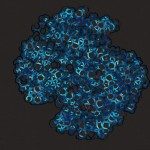Type 2 secretion systems transport proteins in a folded form. The recognition signal that allows specific secretion of type 2 substrates has remained elusive, despite years of studies. In collaboration with the team of Pedro Alzari (StructuralMicrobiology Unit, IP) and Peter J. Bond (University of Cambridge, UK and A-Star Institute in Singapore), we unraveled the dynamic structural motifs that promote secretion of the lipoprotein pullulanase by the type 2 secretion system of Klebsiella oxytoca. To do this, we combined X-ray crystallography, molecular dynamics in model membranes, biochemical analysis, with site-directed mutagenesis and functional assays. The study also revealed the inner membrane lipoprotein sorting signal and the tether, which is disordered in solution, and which is structured in silico and in vivo though multiple contacts with the membrane phospholipid head-groups. The inner membrane acts as a chaperon, preventing degradation of peripherally associated pullulanase domains and also presenting the protein to the secretion apparatus.
The study was published in Structure (Volume 24, Issue 1, p92–104) with the front cover image by Alexandra East and commentary by Jane R Allison (Structure Volume 24, Issue 1, p5–6). DOI: http://dx.doi.org/10.1016/j.str.2015.10.023
Read the story behind the cover of Structure and the mini interview with its author Alexandra East on the Cell blog.
http://www.cell.com/crosstalk/the-story-behind-structures-january-2016-cover







